Street Food - Food Educates!
It is said that Sicilians talk about food when they are not eating. In any case, people in Sicily like to cook as much as they like to eat. If the Sicilian exceptionally lacks time, he trusts even once on fast or street food.
But he would not be a Sicilian if he did not put his personal stamp on it.
What better way to get to know Sicilian and Palermo culture than street food?
We don't think so. Eat smart. The beauty is, nowhere in Palermo is there more street food than in and around Mercato Ballarò.
If you haven't tried the street food in Palermo's markets, you've missed out. It smells so delicious everywhere on the Ballarò that my mouth waters. Especially those who like fried food, indulge here in paradise.
You are open and brave? Just follow your nose. Where it smells delicious, it will taste that way. Or just stand in the longest line at the Mercato. So many people can't be wrong. Make sure that there are Palermitans in the line in front of you, and not just tourists. Then not much can go wrong. Just let yourself be surprised. The vendors are happy about every non-Palermitan who tries their food.
At first glance, you may wonder how it looks with the hygiene on the markets of Palermo. If before you the butcher shoulders half a beef and carries over the market, or in the butcher's shop the meat hangs openly without cooling over the counter. Or the fish is lying there without refrigeration. From experience I can say that I like to shop there and the goods are always fresh. We have never had any problems of any kind.
At my favorite fish stand, a whole tuna is delivered early in the morning. Except on Mondays, because the fishermen don't go out on Sundays. On Mondays, this stand is closed. That best sign that the fish is freshly caught. The fish is then cut up and sold by the piece to the restaurant shoppers who come whizzing up on their Vespas with an order sheet and counted money. And when the fish is sold, which is usually around 10 o'clock, the stand closes.
When I bought the 1st time there tuna, I naively asked if I can eat the tonno raw as sushi. The dealer looked at me with big eyes. Of course. By the way, the prices are daily, I have paid so far per kilo between €6 and €10. Each piece of fish costs the same. Even the coveted El Morillo pieces at the top two head ends. Since I unfortunately know little about fish, I choose the pieces by gut feeling. Feel free to write me in the comments which pieces of tuna you prefer.
You can also eat the tonno grilled directly on the stand. However, the slices are too thin and cooked through for my taste. I prefer thick slices grilled briefly, so that the middle is still raw.
Here is a small overview of the typical Sicilian street food:


Anelletti al forno
Let's start with A and the most famous Italian, if not worldwide, dish - pasta - so after all. And yet this pasta is different. It is mainly typical of Palermo and its province. And it is now also widespread in the rest of Sicily.
The pasta Anelletti consists of small rings and is used only to make this specialty. Actually, it is a classic Sunday and holiday recipe of every nonna. But also as street food you see it more and more often.
Traditionally with ragù, which is simmered for several hours. A regular shot of red wine is important. It is accompanied by caciocavallo cheese, smoked meat, fried eggplant, ricotta salata, hard-boiled eggs, Parmesan cheese and breadcrumbs. After the ragù is ready, everything is baked in the oven "al forno" so that the cheese is also nice and crispy. So it's more or less a pasta bake.


This saffron-flavored rice ball, traditionally stuffed with ragù sauce (tomato, ground beef, peas, onion), dredged in breadcrumbs and deep-fried, is one of the many Arabic legacies of Palermo cuisine. For us, the No. One of street food here. But not everywhere tastes like Nonna's, meaning grandmother's. So it's all the nicer that the supposedly best arancine in town is right around the corner from us:
Pasticceria Porta Sant'Agata di Trentacoste Cristian
Via Porta Sant'Agata, 10, 90134 Palermo PA
Tip: You should not be too late. Already in the late morning, these are usually sold out. If you are late, Cornetto or small tarts are also delicious.
What connects Palermo with Denmark, Norway, Sweden as well as the so-called Finnish Swedes and last but not least Germany, at least the Danish Southern Schleswigians in Germany? No, not Arancine. Or at least only indirectly.
The common feature is the Santa Lucia festival, a saint's feast celebrated on December 13, especially in the far north.
But it is also celebrated in the south, in Italy. More than 1600 years ago, St. Lucia lived in Sicily. She is considered the messenger of light and puts sweets and small gifts on the windowsill or in the shoes of children.
But in Palermo, Santa Lucia is not only considered a messenger of light, she is also said to have delivered the city from a famine that struck Palermo in 1646. On December 13, after many petitions and prayers, a load of grain arrived at the port. However, the Palermitans were so hungry that they did not take the time to grind the flour for bread and pasta, but cooked the grain and seasoned it with a little oil.
Therefore, in memory of this famine, the Palermitans eat arancine on Santa Lucia.
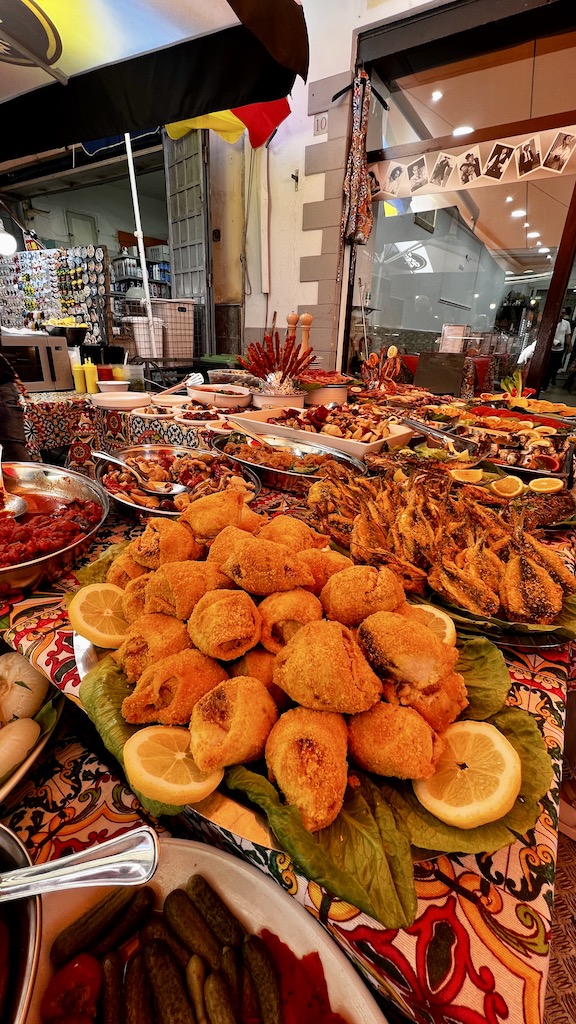
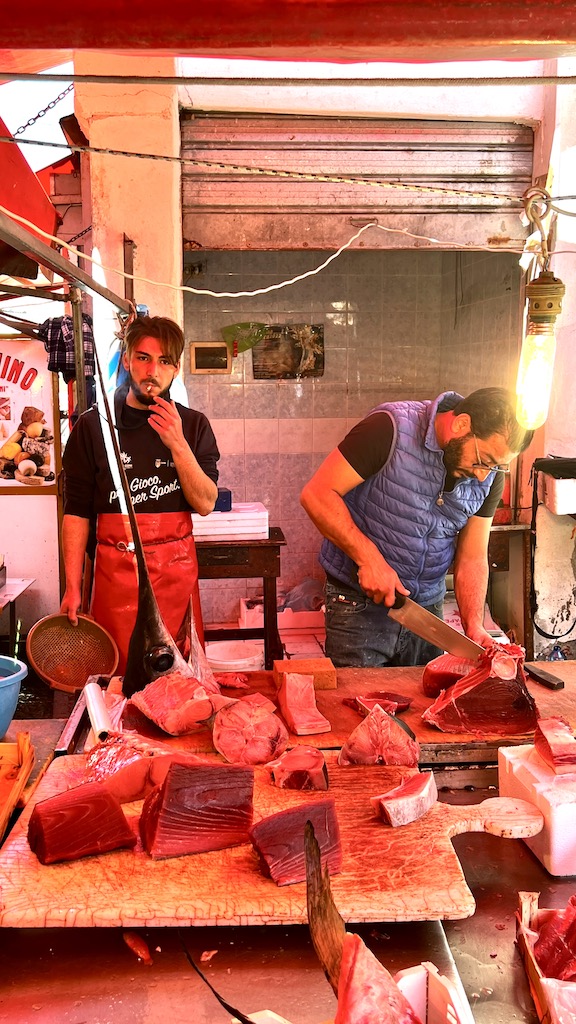
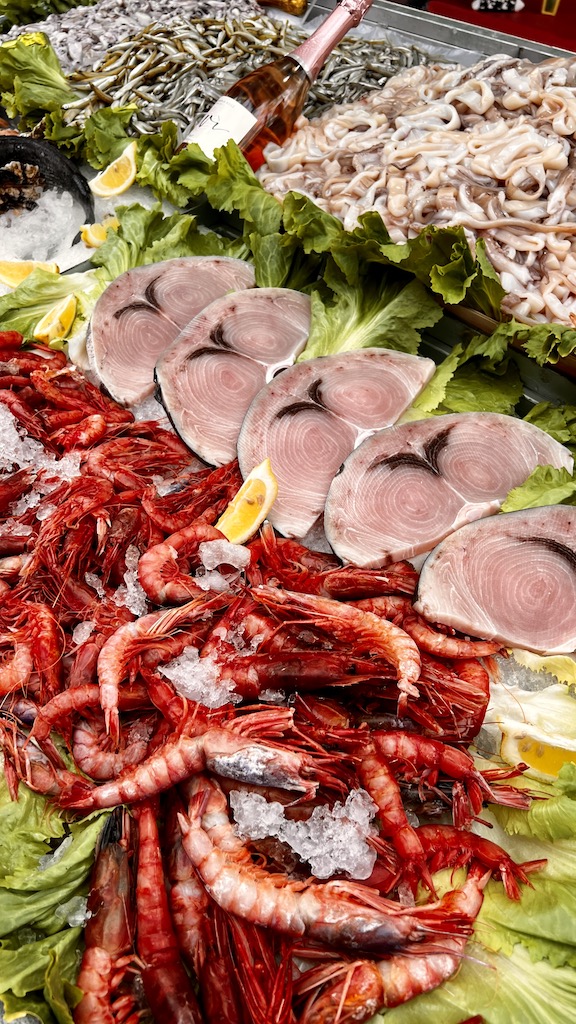
Babbaluci
Marinated snails - used to be traditionally served in July for the feast of St. Rosalia, the patron saint of Palermo. Today they are widely available. They are marinated in salt water for a few days, then cooked and seasoned with garlic and parsley. Maybe not everyone's cup of tea, but still interesting.
Cannolo
While in German-speaking countries large flocks of sheep are becoming increasingly rare, and more and more farms keep their sheep only as a sideline, sheep farming still plays a major role in Sicily. Not only as the basis for delicious meat dishes such as Agneddu 'nfurnatu cu Riganu, spring lamb with fresh oregano, Agnello con Finocchietto, lamb shoulder with wild fennel or Costelette di agnello alle Messina, lamb chops marinated with garlic, chili and lemon zest, simmered in olive oil.
Sheep's cheese such as pecorino and especially ricotta also play a major role in Sicilian cuisine. To the latter we owe a special delicacy, cannolo. Which means something like "small tube". So it is also a tubular, crispy, deep-fried wafer filled with sweet ricotta cheese, chocolate chips and decorated with candied orange peel and chopped pistachios.
Not only special tasty cannolo, but also the perfect place to eat it can be found somewhat hidden near the Quatro Canti, in the...
La Dolceria di Santa Caterina - Piazza Bellini
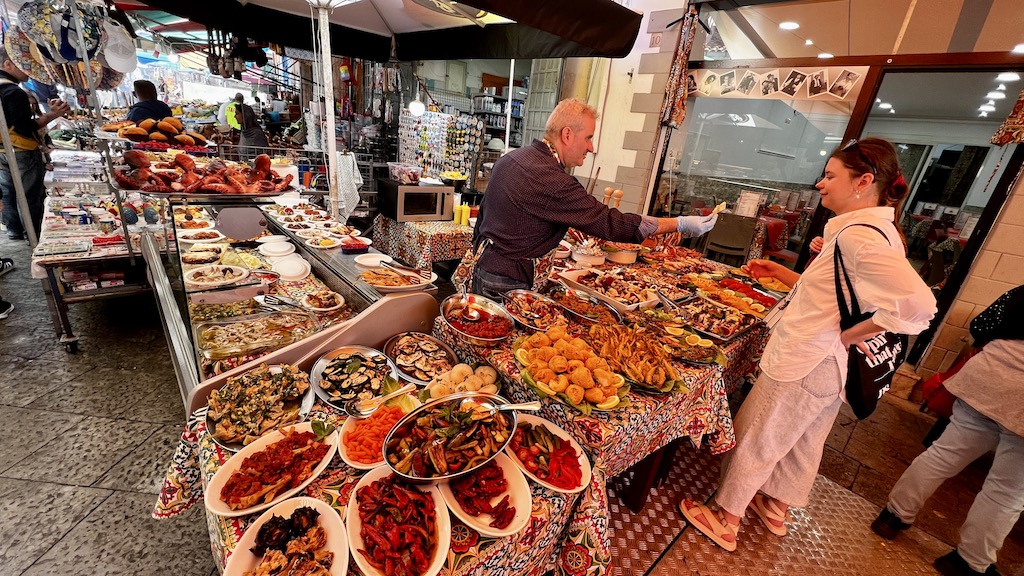
Caponata
In the meantime, I no longer eat caponata only at the markets, but also like to cook it myself. Because Caponata always goes and to everything as a side dish. I always cook a large pot and fill them into jars, which are always gone faster than expected. If it must go fast times simply cold with a piece of bread. Simply delicious. It consists of eggplant, onions, celery, olives, capers and tomatoes. Everything is cooked together and seasoned with vinegar and sugar sweet and sour.
Cassata siciliana
Ricotta also plays a starring role in our next specialty.
La cassata is a kind of sponge cake or layer cake filled with sweet ricotta cheese and chocolate chips. It is decorated with almond paste, sugar glaze and candied fruit. The cake is eaten warm or cold. It can also be served with ice cream. Either way you eat a piece of Sicilian history. Because the name derives from the Arabic " qas at" - "large and round basin". Even today the cassata is baked in a round shape. During the Norman period, nuns allegedly supplemented the typical strip of green marzipan. The Spaniards made their contribution by replacing the short pastry with sponge cake. The candied fruits followed during the Baroque period. All in all, a masterpiece of history. And very, very sweet.
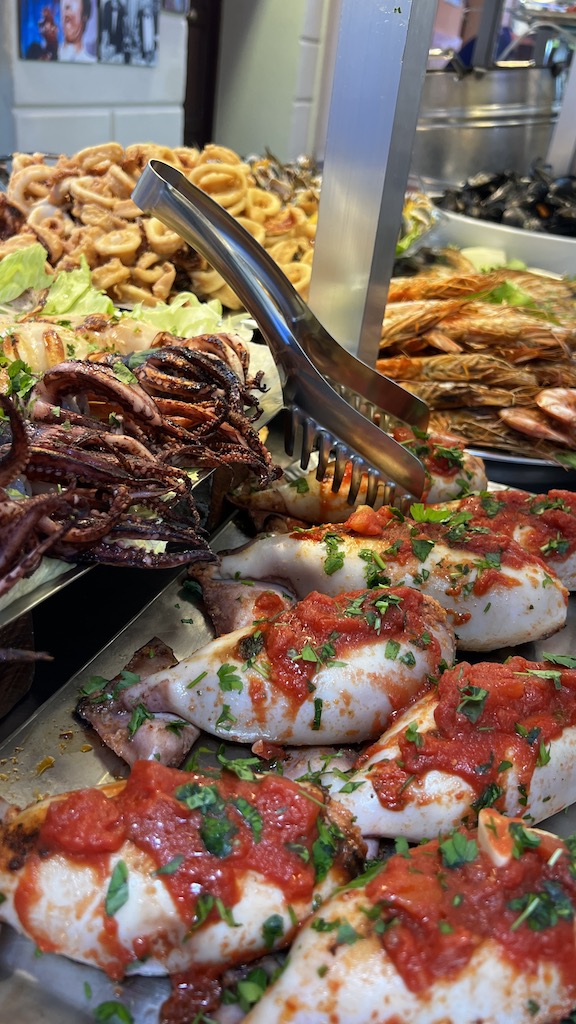
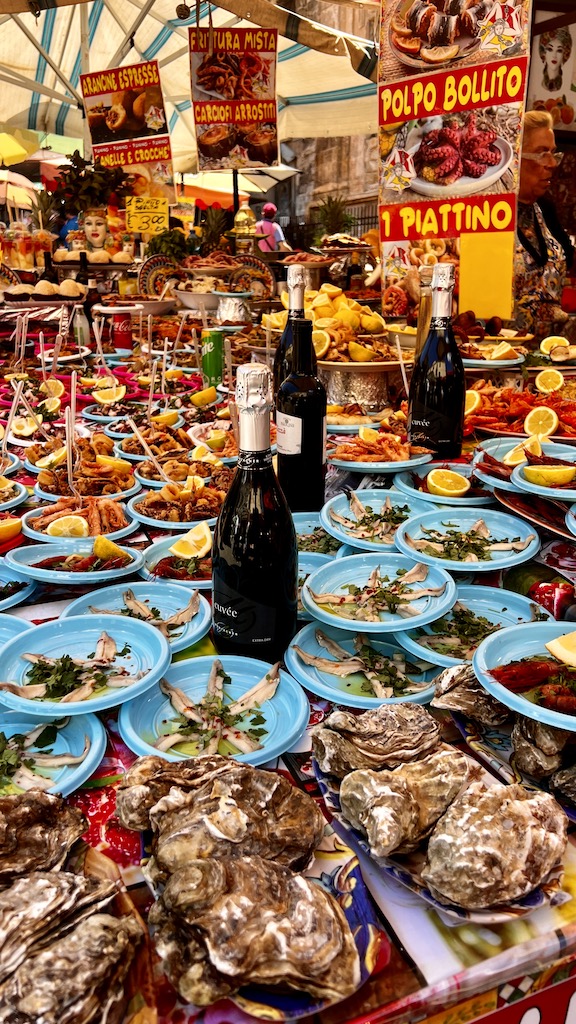
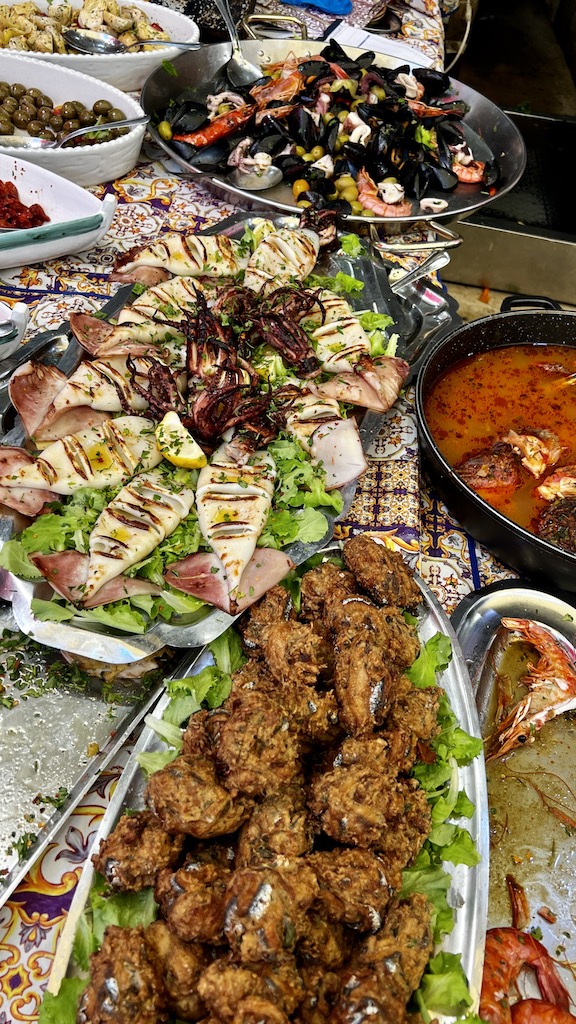
Crocche
Vegetarian potato croquettes seasoned with parsley and mint. Deep fried of course.
Ficurinnia - fichi d'India
The prickly pears are a landmark of Sicily. And the fresh fruits, which are freshly peeled for you in the summer on the market, are mega delicious. I advise against harvesting them yourself, because the thin spines I still had weeks in my fingers. Although I peeled them with gloves under running water.
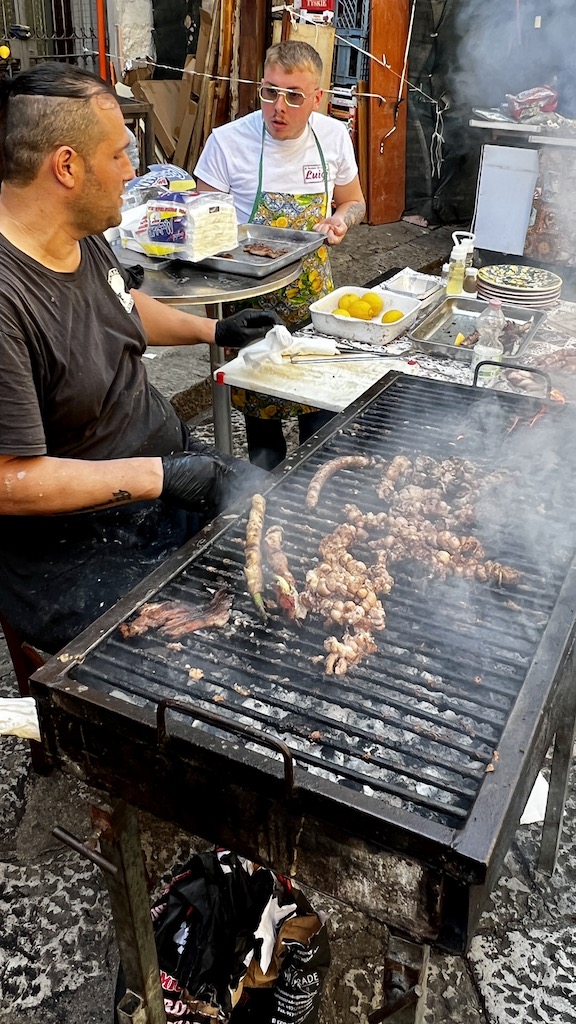
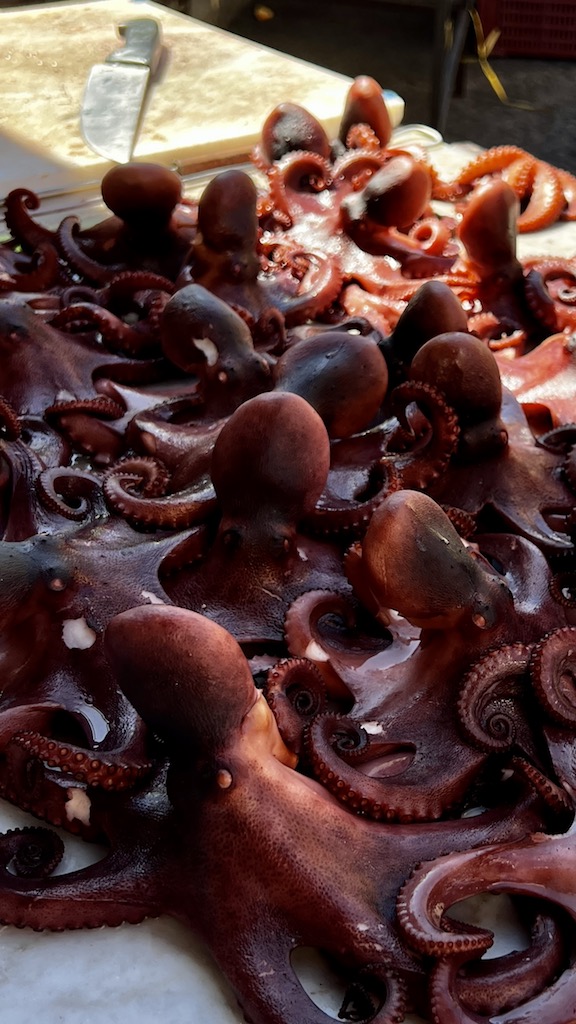
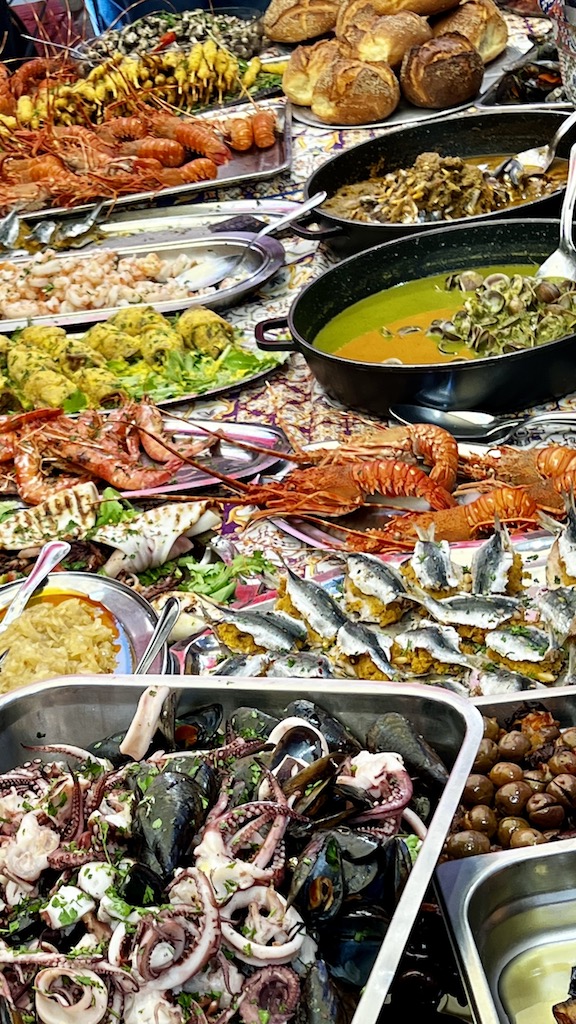
Frittola
This "poor people's food" has become probably the most famous Sicilian street food. It is leftover veal. These are boiled, pressed and deep fried until crispy. You can recognize the frittola stands by the red and white checkered cloth with which the street food is kept warm. Or does it just serve as a view protection? Typically, frittola is taken out with bare hands and stuffed into a bag or bun. Certainly not everyone's cup of tea, but you should try it. Maybe you share a portion with several other people.
Frutta Martorana
The nuns of the convent 'La Martorana' in Palermo originally adopted this marzipan confection from the Arabs and developed it further. For a visit of Pope Clement V in 1308, they wanted to beautify the trees in winter and hung them with fruits made of marzipan.
Today, this marzipan dough, also called pasta reale, is used to shape true works of art in the form of fruits of all kinds. They are not only pretty to look at, but also very tasty. When we celebrated our 1st olive harvest in 2022 with a big party, our Sicilian friends gave us Frutti di Martorana in the form of olives and prickly pears.
For a long time, frutta martorana was traditionally served from November 1 to commemorate the dead. Today it is available all year round.


Gelato and granita
Ice cream always goes. Not only as a dessert or in combination with cake. For us, a good cup of gelato can also replace a main meal. But be careful, not all gelato is the same and not all granita is the same. Whoever says that you can get good gelato everywhere in Palermo is basically right. And yet there are clear differences in taste and, as we find, quality.
In any case, there is variety: fruit, nougat, chocolate, with and without salt. Pistachio and nut. Not only as a cream, but especially with crushed pistachios, peanuts, hazelnuts, walnuts and felt a hundred other nuts. And don't be alarmed, zuppa inglese is not an English soup, but ice cream with candied fruit. The aforementioned cannolo and cassata also come in ice cream versions.
Palermitans also eat ice cream in a sweet bun. Brioche, simply delicious.
As a refreshment and for the small hunger there is granita. A kind of sorbet, water-based ice syrup, usually fruit-flavored. Deliciously tasty, but usually also very sweet. Because granita usually contains a lot of sugar.
However, if you see an Ape in Palermo with the label 'La Frutta di Filice', try it immediately. Here you can get granita made from fresh fruit without the addition of sugar, water, preservatives or other additives. But really delicious.
For all coffee junkies there is granita al caffè, nice with cream on top!
For those who do not want to test all the ice cream parlors, we recommend
Dolce Capo - Via dei Candelai 95 alternative Gelateria Al Cassaro - Via Vittorio Emanuele 214
Involtini melanzane al forno
Very tasty eggplant rolls au gratin. Filled with meat or vegetarian. As an antipasti or side dish.
Pane e Panelle
During our first tours of Ballarò, I saw little yellow squares stacked on top of each other everywhere at the stalls, and wondered what they might be. They are chickpea patties, which how could it be otherwise, are deep-fried. You eat them quite unspectacularly in a sesame seed bun. And this simple vegetarian dish is incredibly delicious. And always goes, even just for the little hunger in between.
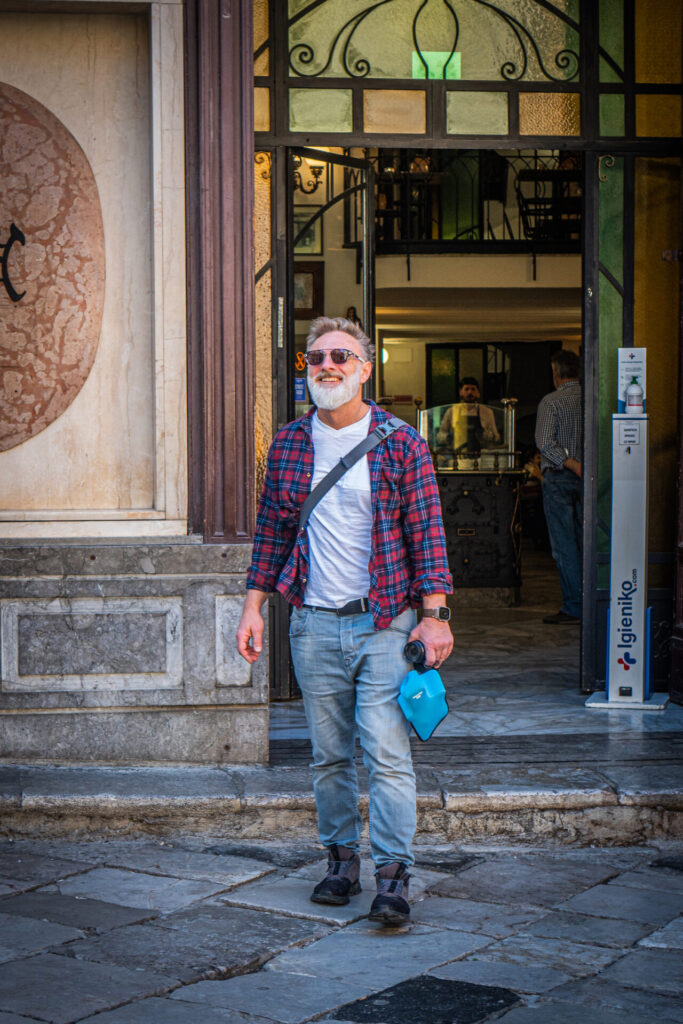
Pani ca meusa
The longest lines at Mercato Ballarò are in the morning at the 'Pane con milza' stands. It is probably the oldest and most popular fast food among Palermitans. But be careful: it is not for the faint of heart. Because it consists, like many street food dishes of Palermo, of offal.
Like most 'cibo della strada', this spleen roll originated as a poor man's food in the Middle Ages. The Jews who worked in the slaughterhouses were paid with the entrails of the animals and then sold them as a filling in bread.
Today, the spleen, lungs and trachea of the calf are cooked, sliced and fried in lard fresh on the spot. This is served as schettu (simple) only with salt, pepper and lemon in a soft sesame bun. Or maritatu (married) with caciocavallo cheese or ricotta. Sounds worse than it is. The long lines at the stands can not be all wrong.
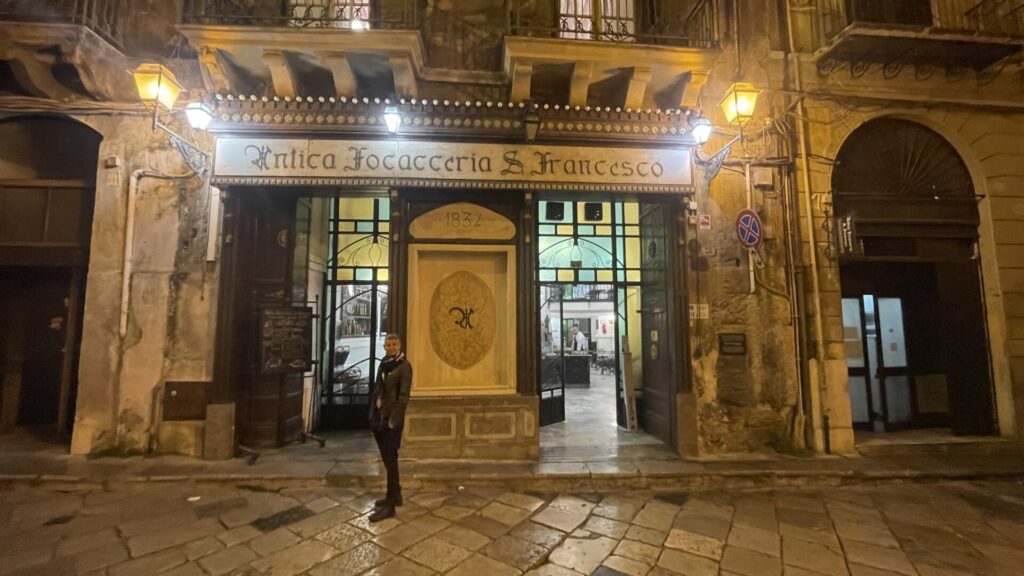
Pasta con le sarde
Sicily is poor, but rich in fish. That is why pasta with anchovies goes so well with Sicilian cuisine. The salty anchovies, combined with raisins and pine nuts, which in turn give the dish a sweet note, the aroma of onions and fennel, which seems to grow everywhere on the island. Most Sicilians always have a bag with them when they go for a walk. Because they cook what they find along the way. Wild asparagus, and in this case fennel.
But the most important thing is muddica atturrata, toasted breadcrumbs, typical of the Palermo version. If you don't have fresh sardines, you can use anchovies. If there is a vegetarian at the table, you can leave out the anchovies. One is flexible. So there is also alternatively the possibility to bake the whole thing in a casserole dish.
But be careful: as soon as a pasta contains fish, do not sprinkle grated cheese over it, but breadcrumbs.

Puippo Vugghiutu - Polpo bolito
Actually, I like to eat octopus. But when these little red creatures look at me, I can't eat them. Yet I'm sure they taste delicious. They are served boiled and cut into small pieces with lemon. Feel free to comment on how you liked them.
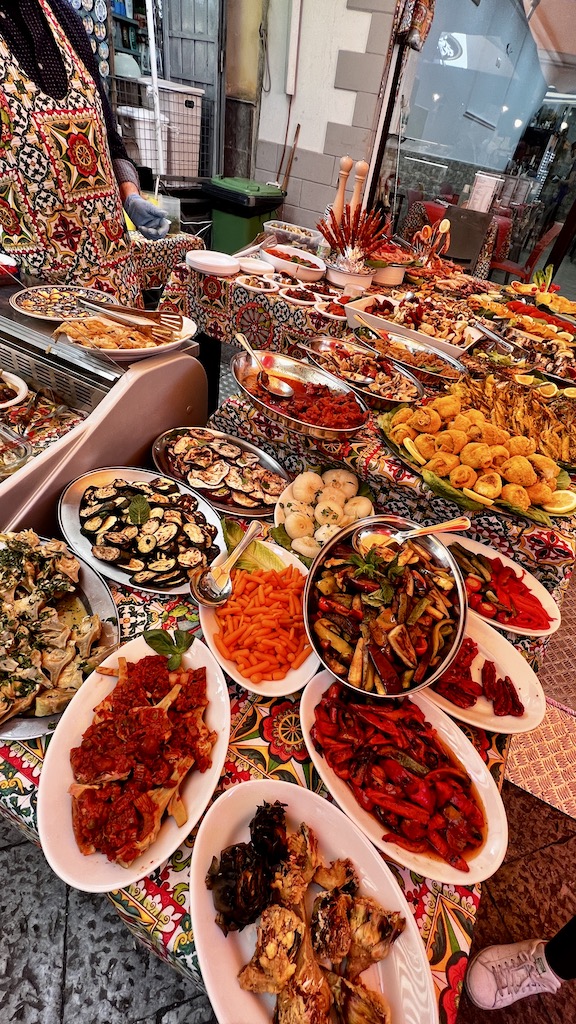
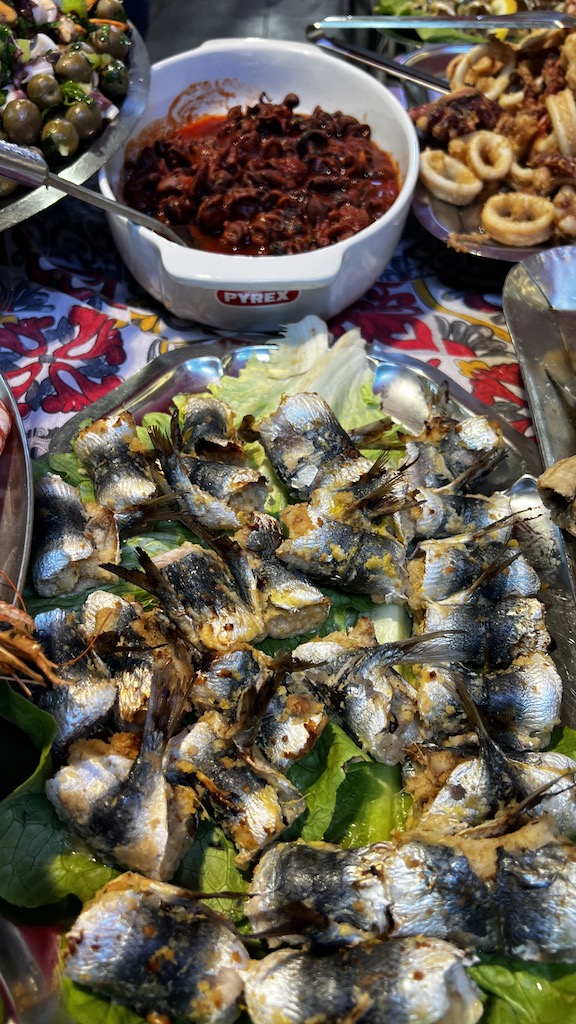
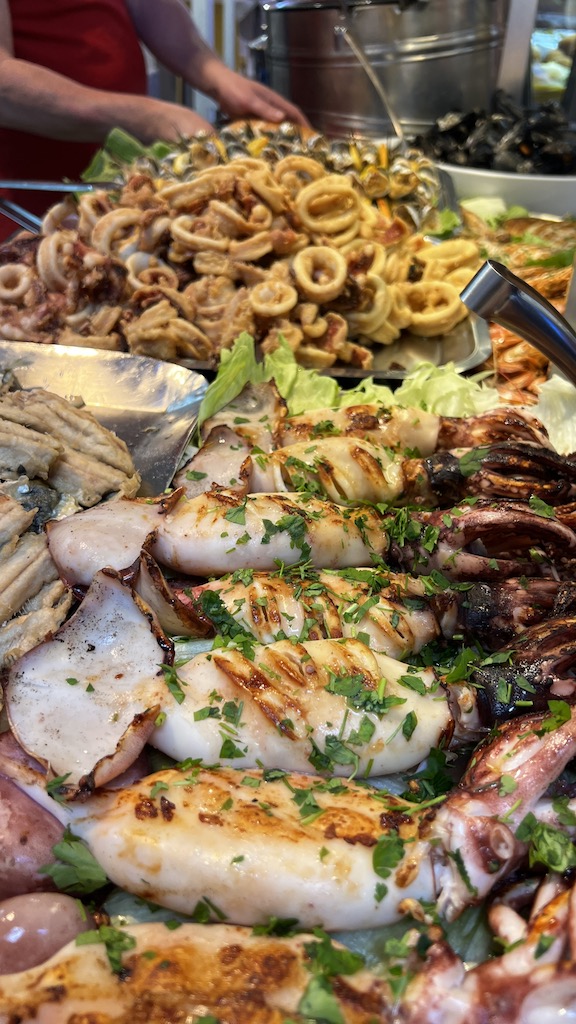
Saidde a Beccafico - Sarde a beccafico
Baked sardine rolls stuffed with breadcrumbs, garlic, parsley, raisins, and pine nuts. Very tasty, you should definitely try.
This dish originated in ancient times, when rich Sicilians hunted and ate the bird beccafico. The poor population, who could not afford this expensive meat, recooked it with sardines, and so it is handed down to this day.
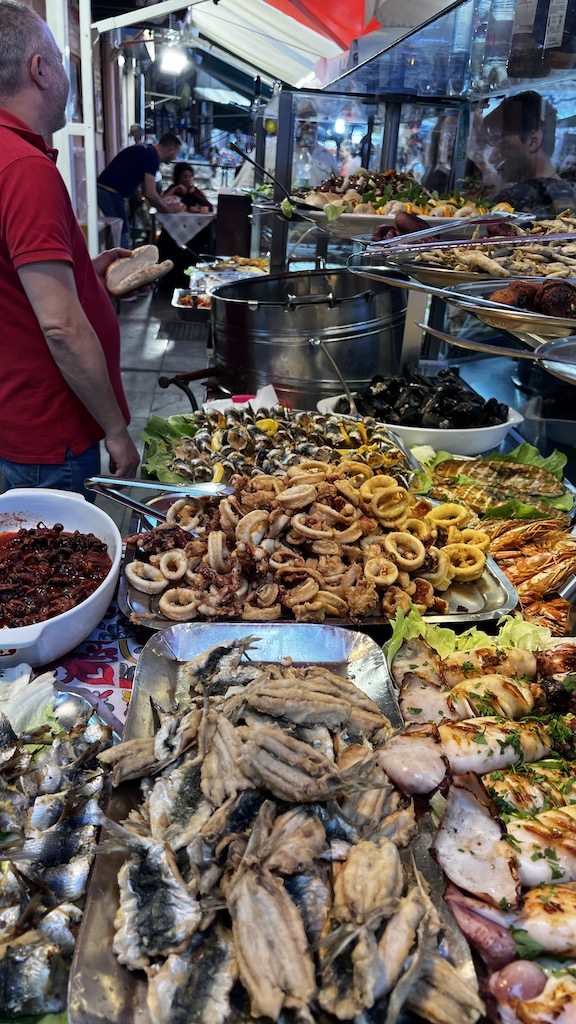
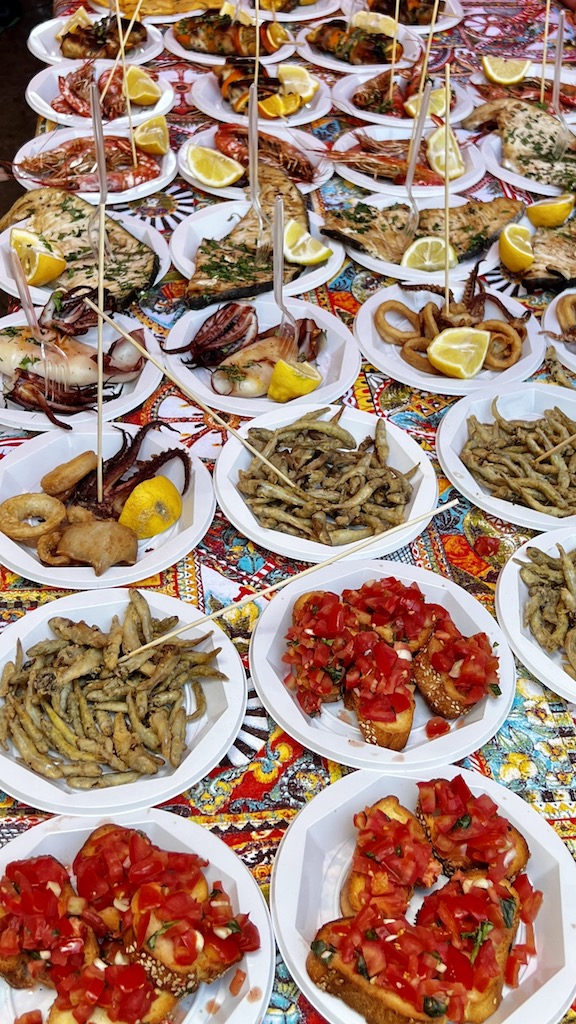
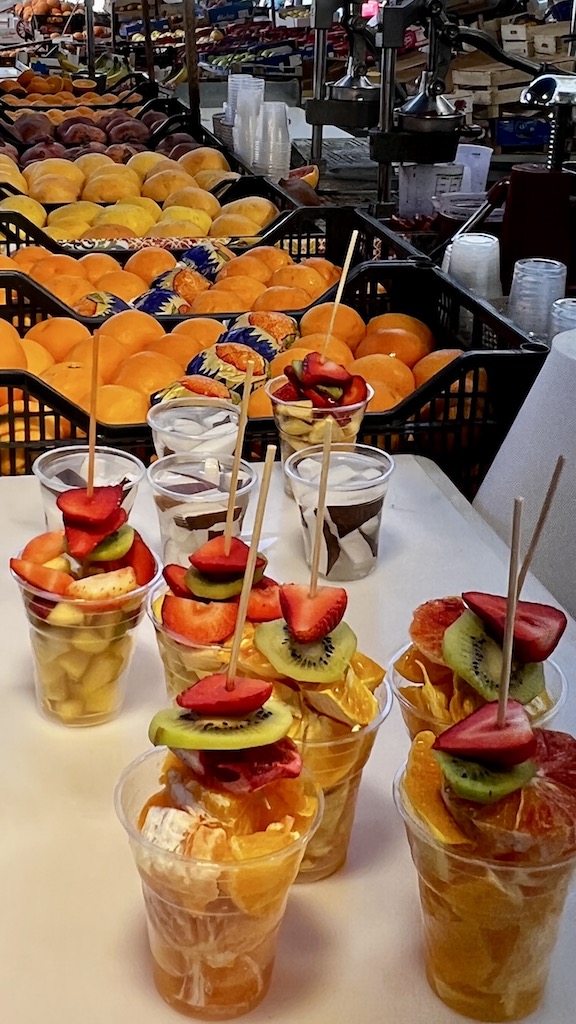
Sfincione
It is neither pizza, focaccia, nor yeast cake. Sfincione is unique and you must try it. The nuns of San Vito in Palermo invented it for the feast of the Immaculate Conception in early December. The name comes from the Latin spongia or Greek spòngos, meaning sponge, and describes the spongy consistency of sfincione.
It is thick and soft, smells delicious and is richly topped with tomatoes, onions, anchovies, caciocavallo cheese, oregano and breadcrumbs. And should not be missing from any Sicilian feast. What used to be available only in December, we can now enjoy all year round, thank goodness.
Stigghiola
Can be found at the street stalls with the biggest column of smoke over the charcoal grill and the most delicious smell. A skewer of lamb , goat or veal intestine wrapped around a spring onion. Tastes better than you think.
Links to supplementary contributions
Since we discover new delicacies at the market almost every week, this list is far from complete. Feel free to write us a comment, what we have forgotten or missed delicious.
Here you can find more information about the Ballaròthe old town of Palermo, the Centro Storico, Palermo Street Art Part 1.


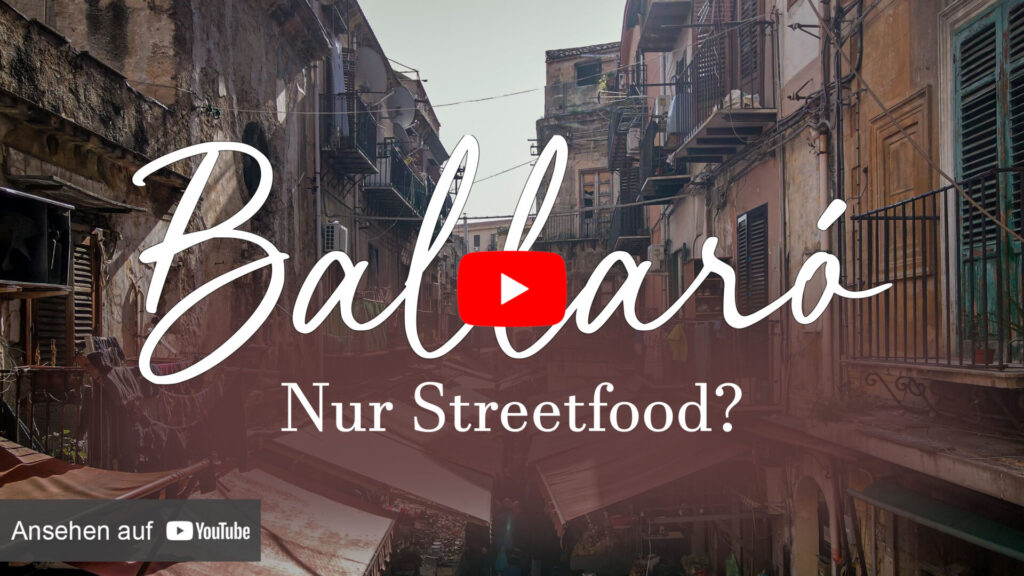
Text and picture whet your appetite and you can literally smell and taste it ... (seriously, that's not fair ... so much to report here about delicious things ...), so - then thanks for inspiration and suggestion. Meal!
Hello Bernhard,
thank you for opening my eyes with your comment. Because I have published a half-finished post.
So I could at least set it to private. You can still see it. Today, our contribution about the Ballarò was actually on the agenda.
To reassure you, this is also about delicious food. We just bought tuna today. Cheap and super tasty in sushi quality. A real alternative to steak.
Good morning Marc,
just read your post about street food in Palermo, thank you so much how inspiring is that. Look forward with you next time to stroll through the market and try much of what you describe. Thank you very much and greetings from Esen / soon again Termini
Michael
My words, food makes you happy. 😁
Oh yes I love (almost) the whole list and miss the street food in Palermo. I only disagree on the first sentence: Sicilians also talk about food when they are eating 😀
LG, ella
Sorry for this fundamental mistake. You are right! 😎